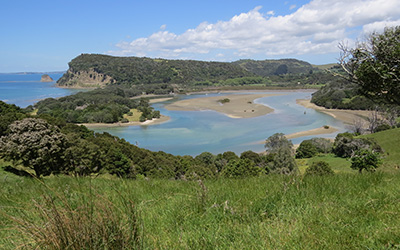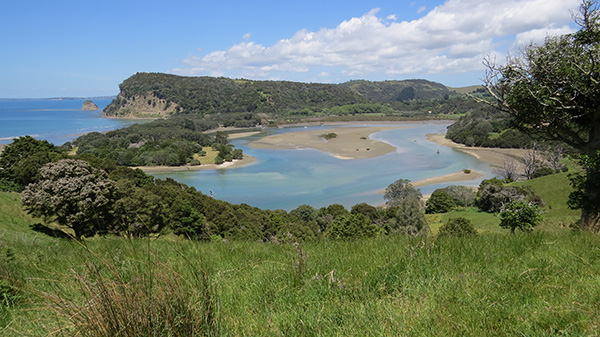Post-Paris regional parks 50th anniversary rethink


Fossil-Fuel-Free Future: Auckland Regional Parks, as magnificently extensive as the network has become, was conceived well before there was any reason to imagine that the era’s car-centric thinking might prove to be catastrophic for life on Earth. Post-Paris, there can be no defence for developing parkland, such as that at Te Muri, primarily for private car access. Wenderholm, from what sanity suggests must become part of Te Araroa. image Mahurangi Magazine
With the 50th anniversary of the opening of Wenderholm to be marked this Friday, supporters are calling for a bold new community–council plan for the regional parks network’s next 50 years.
The original visionaries, the region’s first planner, Frederick W O Jones, and its first parks chairman, Judge Arnold Turner—the latter will attend the ceremony at Wenderholm—had a clear plan of what they wanted to achieve. They were on a mission to preserve Aucklanders’ access to the natural coastline that was rapidly being lost to coastal settlement. Earlier, Jones had failed to get support for the purchase of the northern half of Ōrewa’s beachfront back to the highway, when it could have been purchased by the government for £10 000.
Turner, even then a highly respected planning lawyer, to facilitate Jones’ vision, drafted the clauses in the act of Parliament establishing the Auckland Regional Authority that allowed the first regional park, Wenderholm, to be purchased. That accomplished, Judge Turner said in 2002, the staff was:
inclined to relax as if nothing further was necessary—the land had been protected! But I insisted that the park be made ready and opened for public use by the summer of 1965. I said that Aucklanders were very interested in the acquisition and were entitled to see what their money had been spent on.
Fifty years on Judge Turner’s daughter Bronwen, speaking for Friends of Regional Parks, said:
a new vision and values plan is needed to guide the next 50 years, because at present there is no agreed way forward for how the network can be grown to meet the needs of the region’s burgeoning population.
Ms. Turner believes that the network can increasingly contribute to local economies and communities’ living quality, the reason the organisation has adopted the Mahurangi Coastal Trail as its flagship project. By linking together three spectacular coastal areas of regional parkland, and connecting to Te Araroa, the national walkway, the trail will bring business to the Waiwera, Pūhoi and Mahurangi Harbour communities and create a unique recreation experience.
Cody Mankelow of Pūhoi River Canoe Hire sees a terrestrial Te Araroa link, in addition to the current river-only option, as complementary to his business and, in his submission on the management plan, suggested the specific route the trail might take. Meantime the Mahurangi Coastal Trail Trust has been established with the aim of raising the funds to build the Judge Arnold Turner Footbridge that would span the Pūhoi River, possibly a little upstream from the popular Schischka Homestead at Wenderholm.
Tessa Berger, president of Mahurangi Action, the organisation that proposed the coastal trail as the regional parks 50th anniversary legacy project, said:
Linking 900-hectares of regional parkland to public transport at Waiwera is a practical yet environmentally conscious progression. If Auckland Council planners are to move forward with car access, shown as a priority in the draft plan, we are set to lose what could still be the first non-urban section of Te Araroa north of Auckland.
An early test of whether the enormity of the Paris agreement has dawned on organisations such as Auckland Council, will be whether it continues with business as usual, such as persisting with its plan to develop Te Muri for private car access, or immediately embraces the need to make low-carbon decisions.
